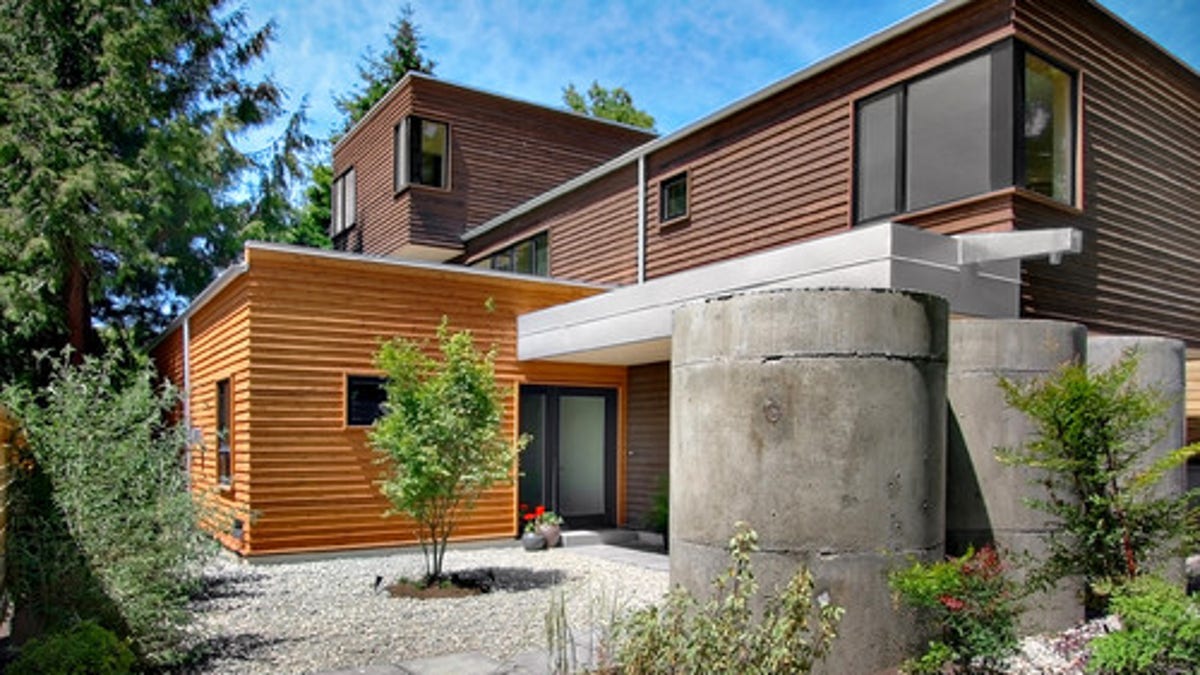
(Houzz/Fivedot Design Build)
Modern architecture may be known for large expanses of glass -- a departure from traditional punched openings in walls -- but small windows still remain in many modern buildings. In many cases small windows offer a challenge for architects, who are otherwise composing facades with larger openings. Yet small openings offer the potential for areas of focus, relief and sometimes whimsy. The following houses present a few examples that juxtapose small windows against larger ones, and for some we'll go inside to see why these petite apertures exist.
While the windows on this home in Seattle are not overly large, the small windows still stand out from the corner windows visible here. Small square windows can be seen on the ground level, in the foreground and on the second floor, above the canopy.
Not surprisingly, at least one of the small windows seen in the previous photo serves a bathroom. Bathrooms are a logical space for small windows, since they allow privacy while still bringing in natural light. Here, the high window allows a view outside, but a soak in the tub is free of prying eyes.
This house on Long Island, in New York, has a number of small openings, three of them visible here: one is in the low link in the middle of the photo, and two are asymmetrically located in the volume on the left
Elsewhere in the house, a bathroom is punctuated by three small openings (at least) on a corner. The sunlight cast on the same walls lets it be known that the room also has a skylight, so the windows are more about views (of the green trees, it appears) than about bringing in natural light.
This view of the double-height living room in the same house has two small windows. While the interior (room-to-room) opening in the center of the photo attracts attention, the one at the top of the stairs is much more interesting. It seems to exist in order to provide a view to somebody standing at the top of the stairs, a very thoughtful gesture.
Many of the walls in the aptly named Copper House are accompanied by large pieces of glass, as can be seen in the left center of the photo. But the wood-clad volume to the right features small windows. Here they are both above and below a snaking canopy, also rendered in copper. (On a side note, the cantilevered scupper shooting to the left is just amazing!)
A close-up of the wood volume reveals the way the windows are set deep into the exterior walls. The windows also follow the horizontal planks, so the wood turns the corner to serve as jambs in front of the windows.
This classically modernist house has a variety of windows -- large, horizontal, corner -- but the small openings (one is visible in the middle of the photo) stand out against the whitewashed walls.
Other small windows are visible elsewhere in the project, which is a grouping of condos, not a single-family house. Based on earlier examples, it's a safe guess that these windows serve bathrooms.
Another project by the same architect, but in a very different style, shows small windows appearing again but more frequently. It's not surprising that this is the house's side elevation, where the informality of such a window composition is more acceptable (front facades being more formal in character).
The grass roof of this distinctive house certainly attracts the most attention, but the horizontal articulation of the small windows is quite interesting, like a line of Morse code. The row of windows sits just above door height, and some are set back from the wood facade.
At the setback portion the windows serve as clerestories in the kitchen. Looking through the window on the left reveals an even smaller opening in the wood wall, which serves the entrance and gives the facade its rhythm.
Related:
- Ideas: Get inspired by 70K window treatment photos
- Help: Find an architect in your area
- Photos: Browse 40K home exterior photos
John Hill is an architect and writer living in New York City. Hill has Bachelor of Architecture and Master in Urban Planning degrees, and over ten years experience in architectural practice, split between Chicago and NYC. He is currently focused on his writing and online pursuits.



















